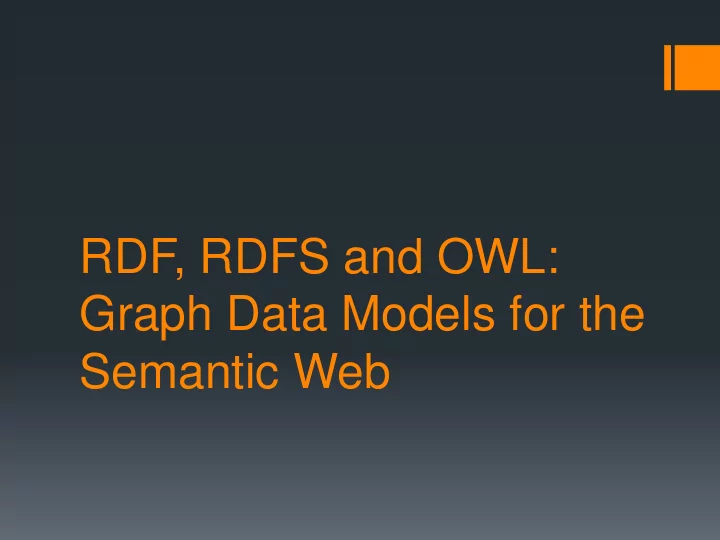

RDF, RDFS and OWL: Graph Data Models for the Semantic Web
Semantic Web: The Idea Semantic Web does not mean computers are going to understand the meaning of everything on the web does mean that we can create some standards ways of representing web-information such the logical pieces of meaning can be mechanically manipulated by programs (applications) in a generic way One such mechanism involves representing, manipulating and using metadata
Linked Data: The Vision Linked Data is about using the Web to connect related data that wasn't previously linked, or using the Web to lower the barriers to linking data currently linked using other methods.
Is there any reason to connect these two pages?
What is RDF? RDF (Resource Description Framework) was originally designed to develop metadata for the web Example: my SDSC web page http://www.sdsc.edu/~gupta dcterms:creator The individual whose name is Amarnath Gupta, email <gupta@sdsc.edu>, is the creator of http://www.sdsc.edu/~gupta name email Amarnath Gupta gupta@sdsc.edu
Another Example Managing Event Information: Modeling, Retrieval, and A book website Applications dcterms:title Literal URI http://www.morganclaypool.com/ doi/abs/10.2200/S00374ED1V0 dcterms:publisher 1Y201107DTM019 Label from Vocabulary Anonymous Node dcterms:creator name Morgan & Claypool http://www.sdsc.edu/~gupta dcterms:creator Now a program can “integrate” information from the two sites http://www.ics.uci.edu/faculty/profil correctly (i.e., by URI and not by es/view_faculty.php?ucinetid=jain value)
URIs Name Definition Example a character string that specifies scheme://username:password@domai URL where a known resource is n:port/path?query_string#fragment_id available on the Internet and the mechanism for retrieving it A character string used to identify a ftp://example.org/resource.txt URI name or a resource on the Internet /relative/URI/with/absolute/path/to/res ource.txt URN A character string that designates urn:isan:0000-0000-9E59-0000-O- the universal name of something. 0000-0000-2 URNs usually use namespaces
Data Types in RDF A data type is: A set of values called the value space A set of character strings called the lexical space A lexical to value mapping RDF has no built-in set of data types of its own In RDF, one uses typed literals and explicitly indicates what datatype should be used to interpret it RDF takes many of its data types from XML Schema xsd:string, xsd:boolean, xsd:date Valid and correct ucsd:85740 exterms:age “31"^^ xsd:integer ucsd:85740 exterms:age “pumpkin"^^ xsd:integer Valid but incorrect
Representing the RDF graph (N-Triples) Representing as a Collection of Edges Subject Predicate Object http://www.morganclaypool.com/doi/a dcterms:creator http://www.sdsc.edu/~gupta bs/10.2200/S00374ED1V01Y201107 DTM019 http://www.morganclaypool.com/doi/a dcterms:title Managing Event Information: bs/10.2200/S00374ED1V01Y201107 Modeling, Retrieval, and DTM019 Applications http://www.morganclaypool.com/doi/a dcterms:publisher :_anon1 bs/10.2200/S00374ED1V01Y201107 DTM019 :_anon1 name Morgan & Claypool http://www.morganclaypool.com/doi/a dcterms:creator http://www.ics.uci.edu/faculty/pr bs/10.2200/S00374ED1V01Y201107 ofiles/view_faculty.php?ucinetid DTM019 =jain
Representing the RDF graph (XML) Representing as Node Properties <rdf:RDF xmlns:rdf="http://www.w3.org/1999/02/22-rdf-syntax-ns#" xmlns:dc="http://purl.org/dc/elements/1.1/" xmlns:edu="http://www.example.org/"> <rdf:Description rdf:about=" http://www.morganclaypool.com/doi/abs/10.2200/S00374ED1V01Y201107DTM019 "> <dcterms:title>Managing Event Information: Modeling, Retrieval, and Applications</dcterms:title> <dcterms:creator rdf:resource =“http://www.sdsc.edu/~gupta” /> <dcterms:creator rdf:resource =“ http://www.ics.uci.edu/faculty/profiles/view_faculty.php?ucinetid=jain ”/> <dcterms:publisher rdf:resource =“:_anon1” /> </rdf:Description> …
Using Data Types in RDF/XML A typical data record <rdf:Description rdf:ID="item10245"> <exterms:model rdf:datatype="&xsd;string">Overnighter</exterms:model> <exterms:sleeps rdf:datatype="&xsd;integer">2</exterms:sleeps> <exterms:weight rdf:datatype="&xsd;decimal">2.4</exterms:weight> <exterms:packedSize rdf:datatype="&xsd;integer">784</exterms:packedSize> </rdf:Description>
RDF and Nested Relations Consider a relation Product with a tuple-valued attribute Name ID Weight Amount Unit ABC 123 34.57 kg The RDF way Product:123 name ABC Product:123 weight _wt1 _wt1 rdf:value “34.57”^^ xsd:decimal _wt1 unit kg
RDF “Collections” RDF Collection <rdf:RDF xmlns:rdf="http://www.w3.org/1999/02/22-rdf-syntax-ns#" xmlns:s="http://example.org/students/vocab#"> <rdf:Description rdf:about="http://example.org/courses/6.001"> <s:students rdf:parseType="Collection"> <rdf:Description rdf:about =“ s:student/Amy"/> <rdf:Description rdf:abouts:student/Mohamed"/> <rdf:Description rdf:about =“ s:student/Johann"/> </s:students> </rdf:Description> The s:students node Has the built-in type rdf:List Is a named closed collection
RDF “Collections” is a List <rdf:Description rdf:about="http://example.org/courses/6.001"> <s:students rdf:nodeID="sch1"/> </rdf:Description> <rdf:Description rdf:nodeID="sch1"> <rdf:first rdf:resource =“ s:student/Amy"/> <rdf:rest rdf:nodeID="sch2"/> </rdf:Description> <rdf:Description rdf:nodeID="sch2"> <rdf:first rdf:resource =“ s:student/Mohamed"/> <rdf:rest rdf:nodeID="sch3"/> </rdf:Description> <rdf:Description rdf:nodeID="sch3"> <rdf:first rdf:resource =“ s:student/Johann"/> <rdf:rest rdf:resource="http://www.w3.org/1999/02/22-rdf-syntax- ns#nil"/> </rdf:Description>
RDF “Containers” rdf:bag – a named unordered collection container membership properties have names of the form rdf:_ n Yes, it is still unordered
RDF “Containers” rdf:alt – represents alternatives (or choices) in a set The semantics of rdf:alt An Alt container is intended to have at least one member, identified by the property rdf:_1. This member is intended to be considered as the default or preferred value.
Reification Sometimes we want to make a statement about a statement “John’s hair - color is black” says his passport. The main statement as a triple (John hair-color black) Now, treat it as an entity called s100 s100:(John hair-color black) Next, make a statement about st (John-passport makes-claim s100) The process is called reification executed through rdf:statement s100 rdf:type rdf:Statement s100 rdf:subject URI(John) S100 rdf:predicate URI(hair-color ) s100 rdf:object URI(black) URI(John) URI(hair-color) URI(black) S100 makes-claim URI(John-passport)
RDF Schema (RDFS) RDF Schema provides a type system for RDF Influenced by objected-oriented languages Classes any resource having an rdf:type property whose value is the resource rdfs:Class. ex:MotorVehicle rdf:type rdfs:Class Instance definition ex:myVehicle rdf:type ex:MotorVehicle Subclass definition ex:Van rdf:type rdfs:Class ex:Van rdfs:subClassOf ex:MotorVehicle A class may be a subclass of multiple classes Transitive property?
RDFS in XML <rdf:RDF xmlns:rdf="http://www.w3.org/1999/02/22-rdf-syntax-ns#" xmlns:rdfs="http://www.w3.org/2000/01/rdf-schema#" xml:base="http://example.org/schemas/vehicles"> <rdfs:Class rdf:ID="MotorVehicle"/> <rdfs:Class rdf:ID="PassengerVehicle"> <rdfs:subClassOf rdf:resource="#MotorVehicle"/> </rdfs:Class> <rdfs:Class rdf:ID="Truck"> <rdfs:subClassOf rdf:resource="#MotorVehicle"/> </rdfs:Class> <rdfs:Class rdf:ID="Van"> <rdfs:subClassOf rdf:resource="#MotorVehicle"/> </rdfs:Class> <rdfs:Class rdf:ID="MiniVan"> <rdfs:subClassOf rdf:resource="#Van"/> <rdfs:subClassOf rdf:resource="#PassengerVehicle"/> </rdfs:Class> </rdf:RDF>
Recommend
More recommend